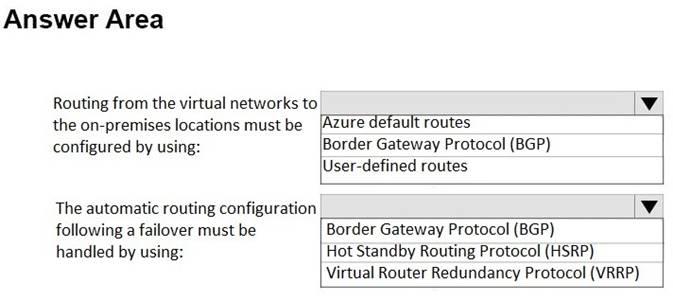- (Exam Topic 1)
You plan to migrate App1 to Azure. The solution must meet the authentication and authorization requirements. Which type of endpoint should App1 use to obtain an access token?
Correct Answer:
D
Scenario: To access the resources in Azure, App1 must use the managed identity of the virtual machines that will host the app.
Managed identities provide an identity for applications to use when connecting to resources that support Azure Active Directory (Azure AD) authentication. Applications may use the managed identity to obtain Azure AD tokens.
Reference:
https://docs.microsoft.com/en-us/azure/active-directory/managed-identities-azure-resources/overview
- (Exam Topic 5)
You need to design a highly available Azure SQL database that meets the following requirements:
* Failover between replicas of the database must occur without any data loss.
* The database must remain available in the event of a zone outage.
* Costs must be minimized.
Which deployment option should you use?
Correct Answer:
D
- (Exam Topic 2)
You are evaluating the components of the migration to Azure that require you to provision an Azure Storage account.
For each of the following statements, select Yes if the statement is true. Otherwise, select No. NOTE: Each correct selection is worth one point.
Solution:
Does this meet the goal?
Correct Answer:
A
- (Exam Topic 5)
Your company has two on-premises sites in New York and Los Angeles and Azure virtual networks in the East US Azure region and the West US Azure region. Each on-premises site has Azure ExpressRoute circuits to both regions.
You need to recommend a solution that meets the following requirements: Outbound traffic to the Internet from workloads hosted on the virtual networks must be routed through the closest available on-premises site.
Outbound traffic to the Internet from workloads hosted on the virtual networks must be routed through the closest available on-premises site. If an on-premises site fails, traffic from the workloads on the virtual networks to the Internet must reroute automatically to the other site.
If an on-premises site fails, traffic from the workloads on the virtual networks to the Internet must reroute automatically to the other site.
What should you include in the recommendation? To answer, select the appropriate options in the answer area. NOTE: Each correct selection is worth one point.
Solution:
Graphical user interface, text, application, email Description automatically generated
An on-premises network gateway can exchange routes with an Azure virtual network gateway using the border gateway protocol (BGP). Using BGP with an Azure virtual network gateway is dependent on the type you selected when you created the gateway. If the type you selected were: ExpressRoute: You must use BGP to advertise on-premises routes to the Microsoft Edge router. You cannot create user-defined routes to force traffic to the ExpressRoute virtual network gateway if you deploy a virtual network gateway deployed as type: ExpressRoute. You can use user-defined routes for forcing traffic from the Express Route to, for example, a Network Virtual Appliance.
https://docs.microsoft.com/ja-jp/azure/expressroute/designing-for-disaster-recovery-with-expressroute-privatepe https://docs.microsoft.com/en-us/azure/expressroute/expressroute-optimize-routing#suboptimal-routing-from-cu
Does this meet the goal?
Correct Answer:
A
- (Exam Topic 5)
Your on-premises network contains a file server named Server1 that stores 500 GB of data. You need to use Azure Data Factory to copy the data from Server1 to Azure Storage.
You add a new data factory.
What should you do next? To answer, select the appropriate options in the answer area. NOTE: Each correct selection is worth one point.
Solution:
Graphical user interface, text, application, email Description automatically generated
Box 1: Install a self-hosted integration runtime
The Integration Runtime is a customer-managed data integration infrastructure used by Azure Data Factory to provide data integration capabilities across different network environments.
Box 2: Create a pipeline
With ADF, existing data processing services can be composed into data pipelines that are highly available and managed in the cloud. These data pipelines can be scheduled to ingest, prepare, transform, analyze, and publish data, and ADF manages and orchestrates the complex data and processing dependencies
References:
https://docs.microsoft.com/en-us/azure/machine-learning/team-data-science-process/move-sql-azure-adf
Does this meet the goal?
Correct Answer:
A

